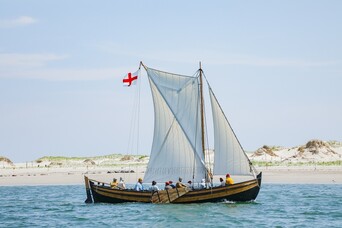Plimoth Patuxet Museums Announces Relaunch of Shallop
Following Routine Maintenance at the Museum’s Maritime Shop, historic reproduction vessel returns to berth next to Mayflower II
Plimoth Patuxet Museums is set to relaunch the Fuller Shallop after completing yearly routine maintenance. This 33’ double-ended sailing and rowing coastal trading vessel is the Museum’s reproduction of the vessel carried aboard Mayflower in 1620. On Monday, July 31, the Fuller Shallop will be launched from Town Pier in Plymouth, Massachusetts, and all are invited to welcome her back into the water.
Carried out by Plimoth Patuxet’s Maritime team of experts, the yearly routine maintenance work on the vessel included cleaning, painting, varnishing, oiling, and sail and rigging inspections and repairs. This important work helps to ensure that the shallop will remain seaworthy for another generation to learn from and enjoy. Once the vessel is returned to its berth next to Mayflower II, the mast will be stepped and the sails bent on. The shallop will remain in the water next to Mayflower II for the busy summer and fall Plymouth visitor season.
“We are delighted to relaunch the shallop and have her back at the pier alongside Mayflower II,” said Whit Perry, the Museum’s Kenneth Shaw Safe, Jr. Director of Maritime Preservation and Operations and captain of Mayflower II. "The routine maintenance work that was so skillfully performed by the Museum's maritime artisans has made the boat shipshape for the public to experience as part of this educational and exciting living history exhibit." This vessel is a reproduction of the one stowed aboard Mayflower during its transatlantic crossing in 1620. The original shallop was used by the Pilgrims as a tender, to transport people and belongings to shore, and to explore the coast. Plimoth Patuxet Museums’ founder, Harry Hornblower, commissioned William Avery Baker – the renowned naval architect who researched and created the plans for Mayflower II – to design a reproduction of the shallop. When Mayflower II arrived in Plymouth in June 1957 the shallop, built at Plymouth Marine Railways, carried Captain Alan Villiers and his crew to shore, where they were welcomed by an estimated 25,000 spectators.

Plimoth Patuxet Museums’ Fuller Shallop
Despite routine maintenance over the last 65 years, both Mayflower II and her shallop succumbed to the deterioration process expected of any wooden boat exposed to the vagaries of salt and sea. Plimoth Patuxet Museums, committed to ensuring the future seaworthiness of these historic vessels, has partnered with other mission-driven organizations to preserve them. The expert boat builders and young apprentices at Lowell’s Boat Shop in Amesbury, Massachusetts worked to bring new life to the shallop in 2020-2021. On April 28, 2021, the newly-restored vessel was re-christened the Fuller Shallop; named in memory of Mayflower passenger and deacon of the Pilgrims’ church, Samuel Fuller.
Note: Several factors, including weather, will affect the launch date. We recommend following Plimoth Patuxet Museums’ social media channels for the latest updates.
About Plimoth Patuxet
Plimoth Patuxet is one of the Nation’s foremost living history museums. Founded in 1947, the Museum creates engaging experiences of history built on thorough research about the Indigenous and European people who met along Massachusetts' historic shores of change in the 1600s. Immersive and educational encounters underscore the collaborations as well as the conflicts of the 17th-century people of this region. Major exhibits include the Historic Patuxet Homesite, the 17th-Century English Village, Mayflower II, and Plimoth Grist Mill. A private, 501(c)(3) not-for-profit educational institution, Plimoth Patuxet is supported by admission fees, donations, memberships, and revenue from a variety of educational programming, dining and gift shops. Plimoth Patuxet receives support from the Massachusetts Cultural Council, private foundations, corporations, and local businesses. For more information, visit plimoth.org. Follow the Museum on Facebook, Instagram, and X/Twitter.